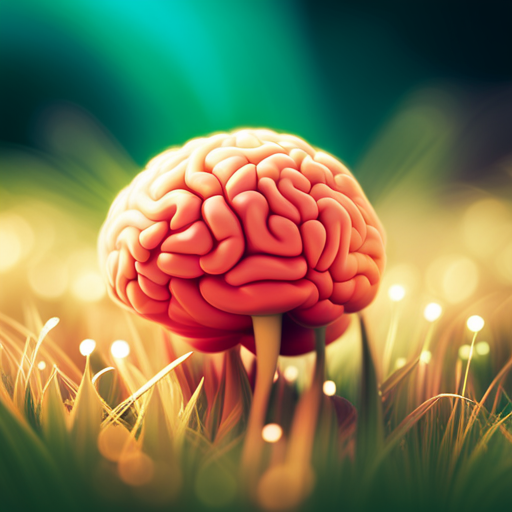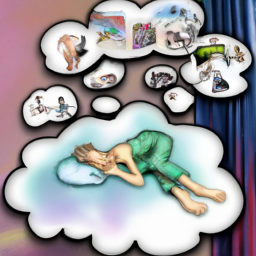Have you ever had the exhilarating sensation of flying through the sky like a magnificent bird, or the fear of being pursued by a fierce creature? These vivid and fantastical experiences are unique to the realm of dreams. Although everyone dreams, not all dreams are alike. Some are brief and easily forgotten, while others stay with us long after we awaken.
So, what makes these dreams so vivid and unforgettable? The answer lies in the fascinating world of sleep cycles. In this article, we will delve into the intricate stages of sleep and uncover which cycle is responsible for those awe-inspiring dreams. Prepare to embark on a scientific journey as we explore the purpose of sleep, the different stages of sleep, and the phenomenon known as REM sleep.
We will unravel the mysterious link between REM sleep and dreams, and discover the characteristics of those vivid and lifelike dreams that leave us in awe. We will also delve into the intriguing concept of lucid dreaming and explore the factors that influence dream recall.
So, fasten your seatbelts and get ready to dive into the captivating world of dreaming, where reality and imagination intertwine in the most extraordinary ways.
Key Takeaways
- REM sleep is the stage where vivid dreams occur.
- Sleep disorders can disrupt REM sleep and decrease vivid dreaming.
- Sleep deprivation reduces the amount of time spent in REM sleep and can lead to difficulties in concentration, memory, and emotional stability.
- Paying attention to the sensory details of dreams can provide insights into their symbolism and deeper meanings.
The Purpose of Sleep and Dreaming
Dreaming during the REM cycle of sleep allows us to explore the depths of our imagination and experience a world beyond reality. It is a fascinating phenomenon that has intrigued scientists and researchers for centuries.
Sleep itself serves various purposes, including restoring and rejuvenating our bodies, enhancing memory, and regulating our emotions. However, the purpose of dreaming is still not fully understood.
One area of interest related to dreaming is sleep disorders. Conditions such as insomnia, sleep apnea, and narcolepsy can disrupt the normal sleep cycle, affecting the frequency and quality of dreams. Understanding the relationship between sleep disorders and dreaming can provide valuable insights into both areas of study.
Another aspect of dreaming that has captivated many is dream interpretation. People have long been fascinated by the symbolism and hidden meanings behind their dreams. Psychoanalysts, psychologists, and even ordinary individuals have tried to decipher the messages that dreams convey. While the scientific validity of dream interpretation remains a subject of debate, it continues to be a popular field of study.
Transitioning to the next section about the different stages of sleep, it is essential to explore the various phases of the sleep cycle in order to fully comprehend the significance of dreaming during the REM stage.
The Different Stages of Sleep
During the different stages of sleep, our minds enter a realm where vivid experiences unfold, like a symphony of images and sensations.
Sleep is divided into two main categories: non-REM sleep and REM sleep. Non-REM sleep is further split into three stages: N1, N2, and N3.
N1 is the lightest stage and occurs when we first fall asleep. N2 is characterized by a decrease in muscle activity and the presence of sleep spindles, while N3 is the deepest stage, also known as slow-wave sleep.
Vivid dreaming is primarily associated with REM sleep, which stands for rapid eye movement sleep. During this stage, our brain activity becomes more active, resembling that of being awake. It is during REM sleep that most of our dreams occur.
Interestingly, sleep disorders such as insomnia, sleep apnea, and narcolepsy can disrupt the normal sleep cycle, leading to a decrease in REM sleep and, therefore, a reduction in vivid dreaming.
Sleep deprivation, whether due to sleep disorders or lifestyle factors, has numerous detrimental effects on the body and mind. It impairs cognitive function, memory consolidation, and emotional regulation. Additionally, sleep deprivation can increase the risk of developing chronic conditions such as cardiovascular disease, obesity, and diabetes.
Understanding REM sleep is crucial in comprehending the significance of vivid dreaming. REM sleep plays a vital role in brain development, memory processing, and emotional regulation.
Understanding REM Sleep
As you enter the realm of REM sleep, your brain activity intensifies, resembling a vibrant symphony of thoughts and emotions. REM sleep, which stands for Rapid Eye Movement sleep, is a crucial stage in the sleep cycle that occurs approximately 90 minutes after falling asleep.
During this stage, your brain becomes highly active, and your eyes move rapidly beneath closed eyelids. REM sleep is associated with a range of benefits for both physical and mental health.
One of the key benefits of REM sleep is its role in memory consolidation. Studies have shown that REM sleep plays a crucial role in consolidating and organizing memories, helping to enhance learning and problem-solving abilities. Additionally, REM sleep is believed to be important for emotional regulation and processing. It allows the brain to process and make sense of the emotions experienced throughout the day, contributing to overall emotional well-being.
On the flip side, sleep deprivation can have a significant impact on REM sleep. When we don’t get enough sleep, the amount of time spent in REM sleep is reduced, which can lead to difficulties in concentration, memory, and emotional stability. Chronic sleep deprivation has also been linked to an increased risk of developing mental health disorders, such as depression and anxiety.
REM sleep plays a vital role in our overall well-being, contributing to memory consolidation and emotional regulation. However, sleep deprivation can disrupt this important stage of sleep and have detrimental effects on our cognitive and emotional health.
Transitioning into the next section, let’s explore the link between REM sleep and dreams.
The Link Between REM Sleep and Dreams
Exploring the fascinating connection between REM sleep and dreams, our minds embark on a nocturnal journey filled with vibrant thoughts and emotions. During REM sleep, our brain activity increases to levels comparable to when we are awake. This heightened brain activity is believed to be the reason why we experience vivid dreams during this stage of sleep.
The link between REM sleep and dreams has been extensively studied by scientists. Through electroencephalogram (EEG) recordings, researchers have found that the brain exhibits patterns of high-frequency electrical activity during REM sleep. This suggests that the brain is highly active and engaged in processing information, leading to the formation of dreams.
Understanding the relationship between REM sleep and dreams has also shed light on various sleep disorders. For example, individuals with REM sleep behavior disorder act out their dreams physically, often resulting in injuries. This disorder occurs when the normal muscle paralysis that accompanies REM sleep is absent, allowing individuals to physically act out their dreams.
As we delve deeper into the characteristics of vivid dreams, we begin to uncover the intricate details of our nocturnal imaginings.
Characteristics of Vivid Dreams
When it comes to vivid dreams, two key characteristics that stand out are emotional intensity and sensory details.
In my research, I’ve discovered that vivid dreams often evoke strong emotions, such as fear, joy, or sadness. These emotions can sometimes linger even after waking up.
Additionally, these dreams are known for their rich sensory experiences. They include vivid colors, sounds, and even smells that feel incredibly real.
Studying the emotional intensity and sensory details of vivid dreams can provide valuable insights into the workings of the human mind during sleep.
Emotional Intensity
During which cycle of sleep do you experience more intense emotions and have vivid dreams? Can you recall a time when you woke up feeling overwhelmed by the emotional intensity of your dreams?
Dream analysis has shown that the stage of sleep known as rapid eye movement (REM) is associated with vivid dreams and heightened emotional experiences. It is during REM sleep that the brain is highly active and the most vivid dreaming occurs. Nightmares, which are often characterized by intense fear and anxiety, are also more likely to happen during REM sleep.
The emotional intensity of dreams can be so strong that upon waking up, one may feel overwhelmed or emotionally drained. Sensory details play a crucial role in the vividness of dreams, as they contribute to the overall immersive experience.
Sensory Details
Immerse yourself in the sensory details of your dreams to truly experience their intensity. Dreams are not just random images that pass through our minds while we sleep; they are complex and meaningful experiences. When we pay attention to the sensory details of our dreams, we can gain insights into their symbolism and better understand their significance.
Dream symbolism is a fascinating field of study that explores the connections between the images and events in our dreams and their deeper meanings. By analyzing the sensory details of our dreams, we can uncover hidden messages and emotions that can guide us in our waking lives. Understanding dream symbolism and interpretation can help us navigate through life’s challenges and make sense of our experiences.
Transitioning into the next section, theories on the function of dreams provide further insights into the purpose and significance of these vivid and sensory-rich experiences.
Theories on the Function of Dreams
In exploring the function of dreams, three key theories stand out: memory consolidation, problem solving, and emotional processing.
Memory consolidation suggests that dreams play a crucial role in solidifying and organizing memories from the day.
Problem solving theory proposes that dreams provide a space for the brain to creatively problem solve and think outside the box.
Lastly, emotional processing theory suggests that dreams allow us to process and regulate our emotions, providing a therapeutic function.
These theories shed light on the potential functions and benefits of dreaming within the realm of sleep science.
Memory Consolidation
Experience a sense of wonder as you enter the mysterious stage of sleep where vivid dreams occur and your memories are consolidated.
During this stage, known as rapid eye movement (REM) sleep, your brain is highly active, and it is during this time that dreams are most likely to occur.
Research suggests that one of the main functions of dreaming is memory consolidation. While you sleep, your brain processes and organizes the information you’ve learned throughout the day, strengthening important memories and discarding irrelevant ones.
This process helps to solidify your learning and improve overall memory performance.
Dream interpretation, however, remains a complex and controversial topic, as the meaning of dreams is highly subjective and can vary greatly among individuals.
Moving forward, let’s explore how dreams can also play a role in problem-solving.
Problem Solving
During the previous subtopic, we explored the concept of memory consolidation during sleep. Now, let’s delve into another fascinating aspect of the sleep cycle: problem solving.
Research suggests that the REM (Rapid Eye Movement) stage of sleep, which typically occurs about 90 minutes after falling asleep, is associated with vivid dreaming. This stage is believed to play a crucial role in problem solving and creativity. While we sleep, our brain engages in problem solving techniques, allowing us to find solutions to complex issues we may be facing. Additionally, dreams can provide valuable insights and inspiration, leading to breakthroughs in our waking lives.
Dream interpretation has long been a subject of interest, as it can help us decipher the hidden meanings behind our dreams and potentially uncover solutions to unresolved problems. By understanding the problem-solving potential of our dreams, we can tap into a powerful resource for personal growth and development.
Transitioning into the next subtopic about emotional processing, let’s explore how sleep contributes to our emotional well-being.
Emotional Processing
Emotional processing during the REM stage of sleep is believed to involve the brain engaging in problem-solving techniques and providing valuable insights and inspiration. This stage of sleep is characterized by vivid dreaming, which plays a crucial role in emotional regulation and dream analysis.
During REM sleep, the brain processes and integrates emotional experiences from the day, allowing us to better understand and regulate our emotions. It is during this stage that the brain consolidates memories and processes emotional stimuli, helping us make sense of our feelings and experiences.
Dream analysis can provide valuable insights into our subconscious mind and help us gain a deeper understanding of our emotions. Understanding the emotional processing that occurs during REM sleep can lead to improved emotional regulation and overall well-being.
Transitioning into the next section, lucid dreaming and control allow individuals to actively participate in their dream experiences.
Lucid Dreaming and Control
If you want to take control of your dreams and experience lucid dreaming, you’ll need to practice reality checks throughout the day. Lucid dreaming is a state in which the dreamer is aware that they are dreaming and can actively participate and manipulate the dream content. There are various techniques that can be used to induce lucid dreams and enhance dream control.
One popular technique is reality testing, which involves performing regular reality checks during waking hours. This involves questioning whether you are dreaming or awake by looking for inconsistencies or unusual occurrences. By doing this regularly, you can train your brain to do the same during your dreams, increasing the likelihood of becoming lucid.
Another technique is called mnemonic induction of lucid dreams (MILD). This involves setting an intention to remember that you are dreaming while falling asleep. Before bed, you can repeat a phrase like "I will have a lucid dream tonight" and visualize yourself becoming aware in a dream. This helps to program your subconscious mind and increases the chances of experiencing lucidity.
A table comparing different lucid dreaming techniques can be seen below:
| Technique | Description |
|---|---|
| Reality Testing | Regularly questioning whether you are dreaming or awake by looking for inconsistencies or unusual occurrences. |
| MILD | Setting an intention to remember that you are dreaming while falling asleep by repeating a phrase and visualizing lucidity. |
| WILD | Entering a dream directly from a waking state by maintaining awareness while the body falls asleep. |
By practicing these techniques consistently, you can increase your chances of having lucid dreams and gaining control over your dream experiences. With further exploration, you can discover additional techniques and find what works best for you. Transitioning to the subsequent section on factors that influence dream recall, it is important to note that dream recall plays a crucial role in the overall lucid dreaming experience.
Factors That Influence Dream Recall
Dream recall can be greatly influenced by various factors, such as the quality of your sleep and the level of stress you experience throughout the day. One effective method for enhancing dream recall is keeping a dream journal. By recording your dreams immediately upon waking up, you can improve your ability to remember them in detail. This practice helps train your brain to prioritize dream recall and increases your overall dream awareness.
Another important factor to consider is your sleep environment. Creating a comfortable and relaxing atmosphere in your bedroom can contribute to better dream recall. Ensure that your sleeping area is free from distractions, such as noise and excessive light. Keeping a consistent sleep schedule and practicing good sleep hygiene can also enhance dream recall.
In addition, managing stress levels throughout the day can positively impact dream recall. High levels of stress can hinder your ability to remember dreams. Engaging in stress-reducing activities, such as meditation or exercise, can improve both the quality of your sleep and your dream recall.
By implementing these strategies and paying attention to the factors that influence dream recall, you can enhance your ability to remember and analyze your dreams. Transitioning into the next section about tips for enhancing dream recall, it’s important to note that these strategies can be further supplemented with additional methods to maximize dream recall.
Tips for Enhancing Dream Recall
Enhancing dream recall can be made easier by implementing simple techniques and tricks. One technique that can help achieve lucid dreaming is reality testing. This involves regularly questioning whether you’re awake or dreaming throughout the day. By consistently practicing this technique, it can become a habit that carries over into your dreams, increasing the likelihood of becoming aware that you’re dreaming.
Keeping a dream journal is another effective method for enhancing dream recall. By recording your dreams immediately upon waking, you’re more likely to remember them in detail. This can also help you identify patterns or recurring themes in your dreams, which can be useful for understanding your subconscious mind.
In addition to reality testing and keeping a dream journal, there are other techniques that can aid in enhancing dream recall. These include maintaining a regular sleep schedule, creating a relaxing bedtime routine, and avoiding stimulants like caffeine before bed.
By incorporating these techniques into your daily routine, you can improve your ability to recall and remember your dreams. This not only allows for a deeper understanding of your subconscious mind but also opens up the fascinating world of dreaming.
The techniques mentioned above, like reality testing and keeping a dream journal, can greatly enhance dream recall. By actively engaging in these practices, you can gain a better understanding of your dreams and delve into the intriguing realm of the subconscious mind.
Conclusion: The Fascinating World of Dreaming
Now that we’ve explored tips for enhancing dream recall, let’s delve into the fascinating world of dreaming itself. Dreams have long intrigued scientists and psychologists alike, offering a window into the mysterious realm of the subconscious mind.
One of the most intriguing aspects of dreaming is the vividness of our dreams and the cycle of sleep in which they occur. During the REM (Rapid Eye Movement) stage of sleep, which typically occurs about 90 minutes after falling asleep, our brain activity increases, and this is when we experience the most vivid and memorable dreams. This is also the stage where our dreams are more likely to be bizarre and surreal, as our brain processes and consolidates emotions and memories from the day. The occurrence of nightmares is also more common during this stage.
Dream interpretation has been a subject of fascination and debate for centuries. While some believe dreams hold hidden meanings and insights into our deepest desires and fears, others argue that dreams are simply a result of random neural firings in the brain. The causes of nightmares can vary, from stress and anxiety to certain medications or sleep disorders.
Dreaming is a complex and captivating phenomenon that continues to be a subject of scientific exploration and interpretation. By understanding the different cycles of sleep and the potential causes of nightmares, we can gain further insights into the fascinating world of dreams.
- Dreams offer a glimpse into the subconscious mind.
- REM sleep is when we experience vivid and memorable dreams.
- Dreams during REM sleep can be bizarre and surreal.
- Nightmares can be caused by various factors such as stress and anxiety.
Frequently Asked Questions
How long does each cycle of sleep typically last?
The duration of each sleep cycle typically lasts around 90-120 minutes. However, it’s important to note that the length can vary depending on several factors.
These factors include age, sleep quality, and overall health. For example, infants tend to have shorter sleep cycles, while adults generally have longer ones. Additionally, external factors such as noise, light, and stress can also impact the length of each sleep cycle.
Can vivid dreams occur during non-REM sleep?
Vivid dreams can occur during non-REM sleep, although they’re more commonly associated with REM sleep. Non-REM sleep is characterized by a lack of rapid eye movement and is divided into several stages. During these stages, dreams tend to be less intense and memorable compared to REM sleep. However, studies have shown that the occurrence of vivid dreams during non-REM sleep can still be indicative of good sleep quality, suggesting that the relationship between dream vividness and sleep quality is complex.
Are all dreams during REM sleep vivid?
Not all dreams during REM sleep are vivid. While REM sleep is commonly associated with vivid dreaming, there are also dreams that occur during other stages of sleep, such as deep sleep. These dreams tend to be less vivid and more fragmented.
However, it’s possible to have vivid dreams during deep sleep by using lucid dreaming techniques. These techniques involve becoming aware that you’re dreaming and being able to control the dream content.
Is there a specific stage of sleep where nightmares are more likely to occur?
Nightmares are more likely to occur during the rapid eye movement (REM) sleep stage. This stage is characterized by increased brain activity and vivid dreaming. The causes of recurrent nightmares can vary, including stress, trauma, medication, and sleep disorders.
To reduce the occurrence of nightmares, techniques such as relaxation exercises, cognitive behavioral therapy, and creating a calming sleep environment can be helpful. It’s important to address any underlying factors contributing to the nightmares for effective management.
Do certain medications or substances affect the frequency or intensity of vivid dreams?
Certain medications and substances can indeed have an impact on the frequency and intensity of dreams. These substances can include alcohol, nicotine, and certain recreational drugs.
Additionally, medications such as antidepressants, antipsychotics, and some sleep aids may also affect dream patterns.
It’s important to note that the specific effects can vary depending on the individual and the dosage of the medication or substance. Further research is needed to fully understand the mechanisms behind these effects.
Conclusion
In conclusion, the world of dreaming is a fascinating and mysterious one. Through the different stages of sleep, particularly REM sleep, we experience vivid dreams that can be both captivating and bewildering.
One interesting statistic is that on average, a person spends about 2 hours in REM sleep each night, which accounts for approximately 20-25% of their total sleep time. This visual representation highlights the significant role that REM sleep plays in our dreaming experiences, showcasing just how integral it is to the overall sleep cycle.









